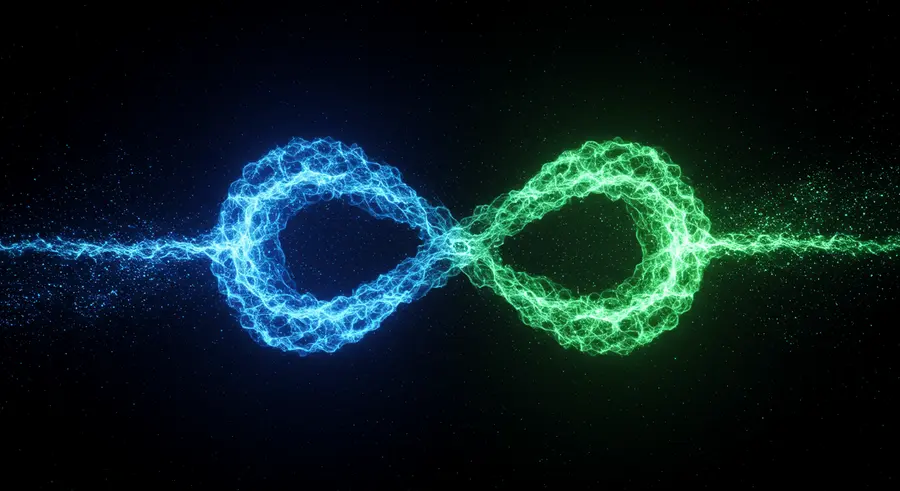Appearance
Unraveling the Enigma: Quantum Entanglement Explained

Quantum entanglement is one of the most perplexing and fascinating phenomena in quantum mechanics. Albert Einstein famously described it as "spooky action at a distance," a testament to its counter-intuitive nature. But what exactly is entanglement, and why does it hold such profound implications for our understanding of the universe and the future of technology?
What is Quantum Entanglement?
At its core, quantum entanglement describes a situation where two or more quantum particles become linked in such a way that their fates are intertwined, regardless of the distance separating them. When particles are entangled, they can no longer be described independently; instead, they form a single quantum system.
Imagine you have two entangled particles, say electrons, and you know they have opposite spins. If you measure the spin of one electron and find it to be "spin-up," you instantly know that the other electron, no matter how far away (even light-years!), will be "spin-down." This instantaneous correlation occurs faster than the speed of light, which initially seemed to contradict Einstein's theory of relativity. However, it's crucial to understand that entanglement doesn't allow for faster-than-light communication of information in the classical sense, as you can't control the outcome of the individual measurements.
Key Characteristics:
- Interconnected Fates: The state of one entangled particle is directly correlated with the state of the other(s).
- Instantaneous Correlation: Measuring a property of one particle instantaneously influences the properties of the other(s), irrespective of distance.
- Holistic System: Entangled particles behave as a single system, even when physically separated.
The "Spooky Action" and Bell's Theorem
The non-local nature of entanglement deeply troubled physicists like Einstein, Podolsky, and Rosen (EPR), leading to the famous EPR paradox paper in 1935. They argued that quantum mechanics was incomplete and that "hidden variables" must exist to explain these correlations without resorting to non-locality.
However, in the 1960s, physicist John Stewart Bell formulated Bell's theorem and a set of inequalities. Experiments testing Bell's inequalities have consistently violated them, confirming the predictions of quantum mechanics and ruling out most local hidden variable theories. This means the "spookiness" is a fundamental aspect of reality as described by quantum theory.
Implications and Applications
Quantum entanglement is not just a theoretical curiosity; it's a cornerstone for emerging quantum technologies:
1. Quantum Computing
Entanglement is a key resource that allows quantum computers to perform calculations far beyond the reach of classical computers. Qubits (quantum bits), when entangled, can explore a vast number of possibilities simultaneously, leading to exponential speedups for certain problems.
2. Quantum Communication and Cryptography
Entanglement can be used to create perfectly secure communication channels. Quantum Key Distribution (QKD) protocols, such as the E91 protocol, leverage entanglement to ensure that any attempt to eavesdrop on the key exchange would inevitably disturb the entanglement, alerting the communicating parties. More on this can be found at the Quantum Computing Report.
3. Quantum Sensing and Metrology
Entangled particles can be used to make measurements with precision far exceeding classical limits. This has applications in fields like medical imaging, navigation, and fundamental physics research.
Current Research and Future Prospects
Scientists are continually pushing the boundaries of entanglement research:
- Entangling Larger Systems: Researchers are working on entangling more particles and even macroscopic objects, though this is incredibly challenging due to decoherence (the loss of quantum properties due to interaction with the environment).
- Long-Distance Entanglement: Efforts are underway to establish entanglement over global distances using fiber optic cables and satellite links, paving the way for a "quantum internet."
- Exploring Entanglement in Biological Systems: Some scientists are investigating whether entanglement plays a role in biological processes, such as photosynthesis or avian navigation, though this is still a highly speculative area.
Conclusion
Quantum entanglement remains one of the most profound and mind-bending concepts in physics. It challenges our classical intuition about space, time, and information, yet it has been experimentally verified countless times. As our ability to harness and control entanglement improves, it promises to unlock a new era of technological innovation, transforming computing, communication, and our ability to probe the deepest secrets of the universe.
While the "spooky action" may still feel mysterious, its reality is shaping the future.
Curious to learn more about the fundamental building blocks? Check out our article on What is Quantum Computing?.